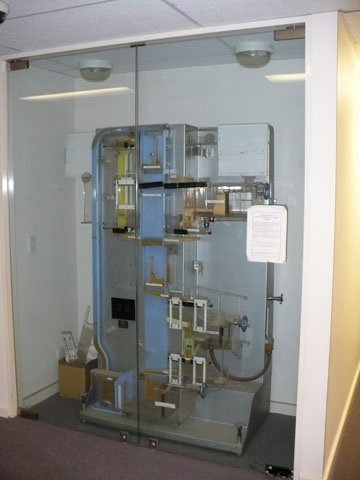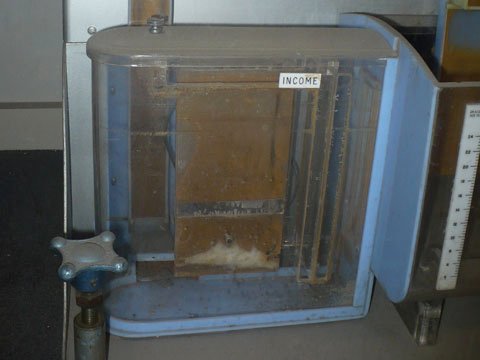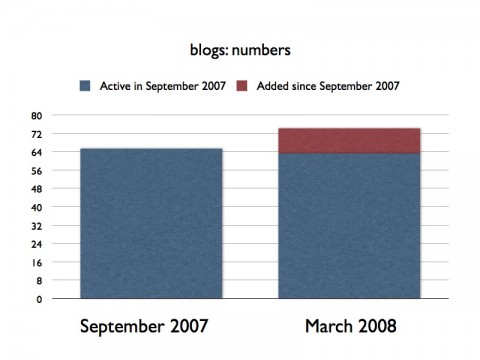Via Old is the New New, MONIAC, the MOnetary National Income Automatic Computer: an analogue hydraulic computer designed by A. W. Phillips, a New Zealander, while a student at the LSE in 1949. The prototype was apparently built out of spare Lancaster parts. And there’s one on display at the University of Melbourne, otherwise known as ‘my uni’, so obviously I had to go and have a look at it!

The MONIAC is currently on the 1st floor of the Economics and Commerce building (on the Parkville campus, off Professors Walk), just opposite the lifts, if anyone wants to visit (though it will probably move to the new building on Berkeley St when that’s finished). It’s a bit over 6 feet high. The bit of paper stuck to the door reads:
MONIAC stands for:
Monetary National Income Analogue ComputerThe MONIAC is a hydraulic model of the economy which was used originally in the teaching of economies. Today, econometric modelling is undertaken in modern Research Computer Laboratories. Visit the Commerce Research Laboratory on this floor to compare the vastly changed environment for teaching and research.
The MONIAC was designed by A. W. Phillips, (an engineer turned economist of “Phillips Curve” fame) who constructed a working model of the Keynesian System utilising coloured water (representing incomes, expenditures, etc) flowing through pipes.
Only 3 or 4 models were built and this is the only known model in Australia. A working model is located in London. The cost of restoring this MONIAC to working has been quoted in the vicinity of $40,000+!
BY THE WAY:
The “Computer” had a reputation for leaking during demonstration!
Could this be the origin of terms used a great deal by Keynesian Economists namely, “Injections” and “Leakages”?
Expressions of interest in contributing to the restoration may be made to the Dean of the Faculty of Economics and Commerce.
However, Wikipedia says that there were 12 to 14 units made. MONIAC caused a sensation at the time (at least among economists!), and was lampooned in Punch. His creation probably helped put Phillips on the fast-track to a full professorship.
The working model in London would be one that’s at the Science Museum; there’s another at Cambridge, and the original prototype is being restored at Leeds.

The national income tank, with a blue pipe (on the left) feeding it in to the rest of the economy. Eventually, the tank gets replenished by greater or lesser amounts, depending on how much is diverted to other parts of the economy. One problem I can see is that it’s a closed system — there’s no way for the economy to grow. Though apparently somebody did link a couple of MONIACs together to show how two economies would interact!

This is where the blue pipe leads to. You can see that part of income gets siphoned off as taxes, the rest going into (naturally enough) income after taxes. The taxes go to government expenditure, income after taxes to savings and (mostly) consumption. There’s a diagram here, which explains it all better than I could.

Back when I was doing computational modelling in a very different domain (astrophysics), we’d sometimes refer to running a model as ‘cranking the handle’. It would have been more fun with actual handles to crank, like this one! Though of course, these would be used to modify variables (e.g. how much is paid in taxes) and not to actually run the simulation.

Here’s one of the outputs, showing national income over time: presumably the board would move from right to left and a pen would move up or down, recording the level of fluid in the income tank (shown in the second photo from the top). But probably more important than this graph was simply watching the fluid (money) pump around the computer (economy); apparently it gave a very vivid and intuitive understanding of the effects a change in one variable would have on another.

The on-off switches for the recorders and pumps, and the name of the manufacturer: Air Trainers Ltd, of Aylesbury in Buckinghamshire. Now this is interesting. As the name suggests, Air Trainers (later Air Trainers Link; later still, General Precision Systems; then in 1967 it was acquired by Redifon, another pioneer of aircraft simulators, and renamed Redifon Air Trainers) made flight simulators, which attempt to imitate the experience of piloting an aeroplane without the need to actually leave the ground. (Something like the Link Trainer, but more sophisticated.) In 1959, for example, they made a simulator for the new Vickers Vanguard, a turboprop airliner. They also made simulators for military aircraft too.
I’ve written before about something closely related to flight simulators, a bombing teacher and the idea of simulation. With Phillips’ help, admittedly, in MONIAC, Air Trainers seems to have gotten past the idea of simulation by imitation and gone on to simulation by abstraction, if still in a physical way. MONIAC would have drawn on some of the company’s strengths, not only in simulation but in hydraulics (an essential component of a flight simulator). And after MONIAC, Air Trainers/Air Trainers Link seems to have kept dabbling in the field of analogue computers. In 1958, they built MAC (simply, Mechanical Analogue Computer), which could solve 4th-order differential equations: Imperial College had one, which is probably the one now in the possession of the Science Museum. Probably related are two patents taken out by people working at Air Trainers Link in 1954 for ‘Improvements in and relating to analogue computers’. They were evidently also looking towards the digital future — there’s a 1959 paper in The Computer Journal from another Air Trainers Link worker about a method for separation of variables, which includes notes ‘on programming the problem for a digital computer’.
This all sounds a bit warfare state, doesn’t it? (Though whether in a deep way or a shallow way, I’m not sure). Consider: (i) Air Link seems to have specialised in simulators for civil aviation, but they also made military ones too. And presumably their expertise was developed during the war, perhaps with Redifon; and anyway Britain’s civil aviation industry was an offshoot of its military one. (ii) In Britain, analogue computers — admittedly electromechanical, not hydromechanical! — started out as aids in solving problems in atomic physics, but then were used for everything from code-breaking to dam-busting (Barnes Wallis supposedly used a Meccano computer for some of his calculations! Though this could just be a myth) (iii) Phillips built his prototype out of RAF surplus kit — pumps and a Lancaster’s windscreen wipers. Before the war, he studied electrical engineering in Britain and joined the RAF in 1940, which sent him to Singapore as a munitions officer. He spent the years 1942 to 1945 in a POW camp in Java, which was brutally used as a source of labour by the Japanese; those who knew him suggested that this experience led him to turn after the war from engineering to sociology and then economics. (iv) Before 1939, government expenditure in Britain was about 10% of GDP; this rose to a massive 54% in the war. So the idea of modelling a national economy must have been attractive to economists after 6 years of a semi-planned wartime economy. ‘At the level of national planning was the consequence, not the cause, of high arms production. It was a means of accomodation to the needs of the warfare state.’1
A good source on MONIAC is Chris Bissell, “The Moniac: a hydromechanical analog computer of the 1950s”, IEEE Control Systems Magazine, February 2007, 69-74; on Phillips, see Robert Leeson, “A. W. H. Phillips M.B.E. (Military Division)”, The Economic Journal 104 (1994), 605-18 (JSTOR). Phillips was a remarkable man. In between New Zealand and Britain, he swagged his way around Australia (working as a crocodile hunter for a while), China (just as the Japanese attacked in 1937) and the Soviet Union (took the Trans-Siberian to Europe). His MBE was awarded for his actions during the evacuation from Singapore, when his transport came under air attack. His citation reads, in part:
he obtained an unmounted machine gun, quickly improvised a successful mounting and operated the gun from the boat deck with outstanding courage for the whole period of the attack which lasted for 3½ hours. Even when the section deck from which he was operating was hit by a bomb, Flying Officer Phillips continued to set a most valuable example of coolness, steadiness and fearlessness to all in the vicinity
While in the POW camp at Bandung (where he met the legendary Australian doctor ‘Weary’ Dunlop), he built a secret radio which enabled the prisoners to keep track of news in the outside world, and, perhaps even more impressively, an immersion heater so that two thousand POWs could have a hot cuppa before bedtime. The Japanese guards could never figure out why the camp’s lights dimmed every night at 10pm.
After a successful career in economics, Phillips switched careers yet again, becoming a Sinologist. He died in Auckland in 1975.
![]() This work is licensed under a Creative Commons Attribution-NonCommercial-NoDerivatives 4.0 International License.
Permissions beyond the scope of this license may be available at http://airminded.org/copyright/.
This work is licensed under a Creative Commons Attribution-NonCommercial-NoDerivatives 4.0 International License.
Permissions beyond the scope of this license may be available at http://airminded.org/copyright/.
- David Edgerton, Warfare State: Britain, 1920-1970 (Cambridge: Cambridge University Press), 72. [↩]






Where were the electromechanical computers used for atomic physics? I hadn’t heard of these. I thought the earliest analogue computers (leaving aside calculators for arithmetic in the tradition of Pascal and Leibniz) were for ballistic calculations, both for creating ballistic tables for artillery, and for bombsights.
All fascinating stuff, and grist to the mill for Rob’s simulation concept course (which I fervently hope will become reality one day.)
Yeah, me too!
I’m thinking of differential analysers … you may be right about the antecedents, not my area! The one I was thinking was a differential analyser built by Douglas Hartree at Manchester University in 1935 (used for Hartree-Fock approximations, which were still being taught to physics undergrads 60 years later). That was inspired by Vannevar Bush’s earlier DA. But you may be right — the DA was invented much earlier, in 1876. Not sure what use it was put to (though it was invented by Lord Kelvin’s brother). In 1912 Pollen used one for his fire-control computer.
You stalking my mates, Holman? I know Chris Bissell – he’s also works at the OU.
I’m sure that this work was picked up by the Treasury. I’d check Agar’s _Government Machine_ for evidence of this, but my copy is AWOL.
So cool! Thanks for this. And, @Chris Wms, I should have known this would connect up to Agar’s Government Machine.
Pingback: The Financephalograph
Stalking, or standing on the shoulders of giants … take your pick!
Well, there’s synchronicity for you! I had a spare afternoon in London on Wednesday and as I was heading for Heathrow via Paddington on the Circle line, stopped off for a visit to the Science Museum. On my way up to the flight gallery I diverted through the computing section to pay homage to the works of Babbage (lots of beautifully polished brass and a great big handle for motive power; some day all computers will be made this way), and just past that section, there was MONIAC. I think it must have gone on display fairly recently, there was an article on it in one of the Sunday heavies. It may well be in working order, but it’s not working; a notice informs interested parties that all fluid has been removed to prevent corrosion.
I wondered about that — I don’t remember seeing it when I was there in July. Though that may have been because I was in a hurry to see the flight gallery that you mention!
Interesting to come across a reference to Air Trainers Link in Aylesbury. This was my first job at 18 (in 1958) and I worked in the drawing office department where I turned out complicated exploded drawings and electrical circuit diagrams. I also designed many of the technical proposal covers of simulators such as the Caravelle, Comet 4B, Lightening and many others. I also printed these covers by hand and still have a few tucked away in the attic somewhere. I also made models for a car simulator and an airfield scene which was painted on a huge canvas roll which rotated in front a TV camera which moved backwards and forwards on a bicycle chain system. They both operated a projected shadow scenes in black and white. It was all very primitive. I made dummy dials for cockpits and all manner of strange things which I didn’t understand. The company was also involved in the first parking meters and I drew and printed the ‘flags’ for these. It was entertaining and interesting and I owe a huge debt of gratitude to a man called Mr Cullimore who employed me and all the other artists who gave me great encouragement. In later life I became a PPL. Oh happy days.
Thanks — very interesting!
Interesting to read of the original ‘roller towel’ flight simulator. At that time I worked at Dexion Ltd, we were asked to design a framework to carry the roller assembly plus the camera carriage mounted on the front of the unit I was concerned with the development of the frame system, and later installed these frameworks Warton (English Electric) and several other airport sites for pilot training. I left this area of manufacture at about the tome that GPS was taken over. I seem to recall that manufacture of the later developments of the system were carried out elsewhere. One man was reponsible for the dreation of the practical aptical system used to gether with the actual design and laborious process of building the 3-D
from detailed photographs of the airport locations involved. Wish I could remember more!
Thanks, Alan. It’s always interesting to hear first-hand recollections.